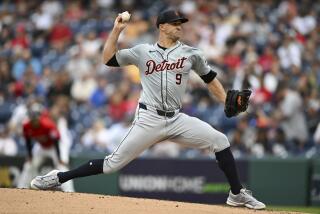Weight Wasn’t an Issue in Hoyt Trade
- Share via
CHICAGO — Since LaMarr Hoyt was traded to the Padres two months ago, his weight has been a heavy issue.
According to somewhat popular opinion, Hoyt went from 24 wins in 1983 to 13 in 1984 with the Chicago White Sox because he was overweight.
White Sox General Manager Roland Hemond, who traded to the Padres, did not concur with such an evaluation Monday afternoon.
“He looked heavy in 1983 and won the Cy Young,” he said. “Nobody made an issue of his weight because of that. Nobody said he was slim in 1983.”
And nobody said Hoyt was slim in 1984. Although listed at 244 pounds in the White Sox media guide, Hoyt reportedly weighed 265 pounds at one point.
When Hoyt appeared at a San Diego press conference last month, he weighed 245.
“I know LaMarr is a smart guy,” Hemond said. “If he felt weight was a detriment, he would take the proper steps to get it down. I saw where he has decided to do that. I thought he would have done that for us if we would’ve kept him.”
When Hoyt led the White Sox to the American League West championship in 1983, Hemond was named UPI’s major-league Executive of the Year.
But after Chicago tied for fifth in 1984, Hoyt became available. Hemond said if the White Sox had repeated in 1984, he “might not have done certain things” that he did after the season.
Among those things, he suggested, was trading the 30-year-old Hoyt.
“We had not set out to trade him at the winter meetings,” Hemond said. “Until we got the proper people from San Diego, we were not going to make a trade.
“LaMarr has all the ingredients of a 20-game winner for them. He has great control, and he knows how to pitch. If they play well behind him, he’ll win.”
Hemond said the White Sox were able to fill several needs in the seven-player trade involving Hoyt.
Chicago expects Ozzie Guillen, who played at Las Vegas last year, to be its shortstop for years to come. Tim Lollar will join the five-man pitching rotation, attempting to fill the gap left by Hoyt. Luis Salazar will likely be at least a part-time starter at third base, and he may be a defensive outfield replacement as he was at times with the Padres.
San Diego also received two minor-league pitchers in the trade, and the White Sox received one minor-league pitcher.
Hemond likened the trade to when the White Sox obtained an unproven Hoyt after the 1977 season from the New York Yankees. Chicago had received Hoyt, Oscar Gamble, a minor-league pitcher and cash for Bucky Dent.
Both the Yankee trade of 1977 and Padre trade of 1984 were not well-received on the south side of Chicago.
“People were shocked that we would trade a big winner like Hoyt,” Hemond said. “Yet people who have seen Lollar and Salazar at Wrigley Field say they are good players. And Guillen was the Player of the Year in the Venezuelan League.
“I like it when trades like this are not applauded. We also were unpopular for trading Dent to New York for Hoyt. We try to perpetuate things like that. Some day, we may trade one of these guys from San Diego and people won’t like it.”
Hemond’s observations of the players he obtained from the Padres:
Guillen: “He has the makings of a very fine future. I don’t think we would have made the trade without him. He looks ready to play for us now. We’ll find out in spring training.”
Lollar: “He will offset the loss of Hoyt to some extent. We’ve seen a lot of pitchers come of age at the point he’s at in his career. That’s a chance you take. With a little better control, he could make a difference. Sandy Koufax used to be as wild as could be. When he found the plate, he was great.”
Salazar: “He gives us versatility. By getting him, we were able to trade (third baseman) Vance Law to Montreal for Bob James, who will give us relief help. Salazar could also help us in the outfield.”
If things do not work out as planned for the White Sox, Hemond will certainly get even more heavy criticism for trading Hoyt.
More to Read
Go beyond the scoreboard
Get the latest on L.A.'s teams in the daily Sports Report newsletter.
You may occasionally receive promotional content from the Los Angeles Times.










